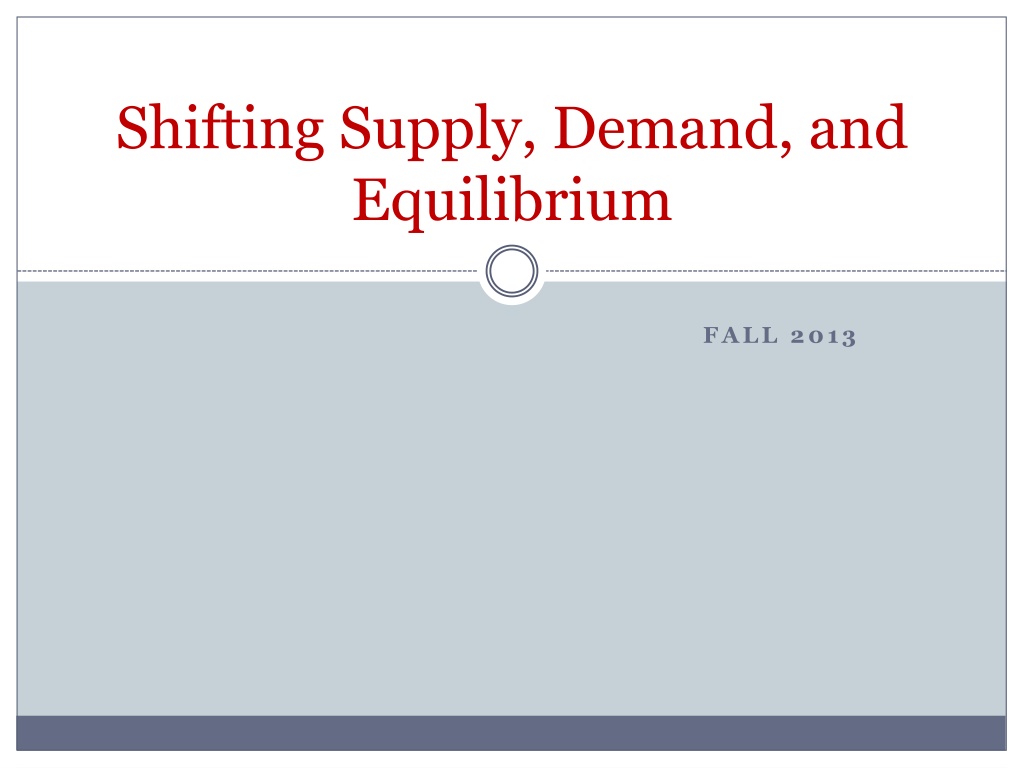Understanding Changes in Demand for U.S.-Made Cars
Explore scenarios affecting the demand for U.S.-made cars, such as changes in income, influx of immigrants, price fluctuations of foreign autos, public transportation availability, and rises in the price of domestic automobiles. Learn how each scenario can lead to shifts in demand curves and impact the equilibrium in the automobile market.
Download Presentation

Please find below an Image/Link to download the presentation.
The content on the website is provided AS IS for your information and personal use only. It may not be sold, licensed, or shared on other websites without obtaining consent from the author. Download presentation by click this link. If you encounter any issues during the download, it is possible that the publisher has removed the file from their server.
E N D
Presentation Transcript
Shifting Supply, Demand, and Equilibrium FALL 2013
Reasons for Changes in Demand Assume that Demand Curve B represents the baseline (original) annual consumption of U.S.-made cars. For each of the following scenarios, decide: 1. Will this event cause a shift in the demand curve? 2. If so, will the demand increase or decrease? 3. Which demand curve likely represents the new demand for cars?
Reasons for Changes in Demand: Scenarios Does demand shift? Increase or Decrease? New Demand Curve Scenario Consumers Income Drops Millions of Immigrants Enter the U.S. Price of Foreign Autos Drop Major Cities Add Inexpensive Bus Lines Price of U.S. Autos Rises Price of U.S. Autos Expected to Rise Soon Families Look Forward to Summer Vacations U.S. Auto Firms Launch Effective Ad Campaigns
Scenario 1: Consumers Income Drops This is a Change in Income. Because they will have less money to go around, consumers will buy fewer cars regardless of price. As a result, the demand curve will shift left to Curve A representing the decrease in demand.
Scenario 2: Millions of Immigrants Enter the U.S. This is a Change in the Number of Consumers. Because there will be more consumers to buy (regardless of price concerns), sales of automobiles will increase. As a result, the demand curve will shift right to Curve C representing the increase in demand.
Scenario 3: Price of Foreign Autos Drop This is a Change in the Price of a Substitute Good. Consumers will be more likely to buy the foreign cars, reducing the demand for domestic (U.S.-made) automobiles. As a result, the demand curve will shift left to Curve A representing the decrease in demand.
Scenario 4: Major Cities Add Inexpensive Bus Lines This is a Change in the Price of a Substitute Good. Consumers will be more likely to ride public transportation, reducing the demand for cars. As a result, the demand curve will shift left to Curve A representing the decrease in demand.
Scenario 5: Price of U.S. Autos Rises While people will buy fewer cars as a result of the increase in price, this is movement along the original curve so there is no shift. The graph of car demand stays at Curve B.
Scenario 6: Price of U.S. Autos Expected to Rise Soon This a Change in Expectations. Because they anticipate rising prices to come, consumers will choose to buy now. As a result, the demand curve will shift right to Curve C representing the increase in demand.
Scenario 7: Families Look Forward to Summer Vacations This a Change in Expectations. Consumers are looking forward to greater utility of cars in the near future. (Road trip!) Therefore, they shop for a new car. As a result, the demand curve for cars shifts right to Curve C representing the increase in demand.
Scenario 8: U.S. Auto Firms Launch Effective Ad Campaigns This is a Change in Tastes. The U.S. auto industry is able to convince consumers that they should be American-made, thus increasing sales. As a result, the demand curve shifts right to Curve C representing the increase in demand.
Reasons for Changes in Demand: Scenarios Does demand shift? Increase or Decrease? New Demand Curve Scenario Consumers Income Drops Yes Decrease A Millions of Immigrants Enter the U.S. Yes Increase C Price of Foreign Autos Drop Yes Decrease A Major Cities Add Inexpensive Bus Lines Yes Decrease A Price of U.S. Autos Rises No B Price of U.S. Autos Expected to Rise Soon Yes Increase C Families Look Forward to Summer Vacations Yes Increase C U.S. Auto Firms Launch Effective Ad Campaigns Yes Increase C
Reasons for Changes in Supply Assume that Supply Curve B represents the baseline (original) supply of U.S.-made cars. For each of the following scenarios, decide: 1. Will this event cause a shift in the supply curve? 2. If so, will the supply increase or decrease? 3. Which supply curve likely represents the new supply for foreign and domestic cars?
Reasons for Changes in Supply: Scenarios Does supply shift? Increase or Decrease? New Supply Curve Scenario Auto Workers Union Agrees to Wage Cuts New Robot Technology Increases Efficiency Price of U.S. Cars Increases Nationwide Auto Workers Strike Begins Cost of Steel Rises Major Auto Producer Goes Out of Business Buyers Reject New Car Models Government Gives Car Producers a Subsidy
Scenario 1: Auto Workers Union Agrees to Wage Cuts This is a Change in Input Prices. Because they ll be able to pay their workers less, this reduces the unit cost to produce cars so suppliers have an impetus to produce more. As a result, the supply curve will shift to the right to Supply Curve C representing the increase in supply.
Scenario 2: New Robot Technology Increases Efficiency This is a Change in Technology (which is also an Input). Because they ll be able to produce cars more efficiency, this reduces the unit cost to produce cars so suppliers have an impetus to produce more. As a result, the supply curve will shift to the right to Supply Curve C representing the increase in supply.
Scenario 3: Price of U.S. Cars Increases While producers will make more cars as a result of the increase in price, this is movement along the original curve so there is no shift. The graph of car supply stays at Curve B.
Scenario 4: Nationwide Auto Workers Strike Begins This is a Change in the Number of Producers. The strike will eliminate domestic automakers from car production, so fewer suppliers will be producing and fewer cars are being produced. As a result, the supply curve will shift to the left to Supply Curve A representing the decrease in supply.
Scenario 5: Cost of Steel Rises This is a Change in Input Prices. Because they ll have to pay more for steel used in production, this increases the unit cost to produce cars so suppliers choose to produce less. As a result, the supply curve will shift to the left to Supply Curve A representing the decrease in supply.
Scenario 6: Major Auto Producer Goes Out of Business This is a Change in the Number of Producers. The plant closing will remove this automaker from car production, so fewer suppliers will be producing and fewer cars are being produced. As a result, the supply curve will shift to the left to Supply Curve A representing the decrease in supply.
Scenario 7: Buyers Reject New Car Models This is movement along the original curve, so there is no shift. This is a shift in demand, not supply. The graph of car supply stays at Curve B.
Scenario 8: Government Gives Car Producers a Subsidy This is a Change in Input Prices. The government subsidy will decrease the overall cost of operations for the automobile industry, making it more profitable to produce more cars. As a result, the supply curve will shift right to Curve C representing the increase in supply.
Reasons for Changes in Supply: Scenarios Does supply shift? Increase or Decrease? New Supply Curve Scenario Auto Workers Union Agrees to Wage Cuts Yes Increase C New Robot Technology Increases Efficiency Yes Increase C Price of U.S. Cars Increases No B Nationwide Auto Workers Strike Begins Yes Decrease A Cost of Steel Decreases Yes Increase C Major Auto Producer Goes Out of Business Yes Decrease A Buyers Reject New Car Models No B Government Gives Car Producers a Subsidy Yes Increase C
Determining Equilibrium Putting Supply and Demand together shows the actual price at which a good is bought and sold. Market equilibrium when the price has moved to a level at which the quantity of a good demanded equals the quantity of that good supplied.
Finding Equilibrium Price and Quantity The easiest (and best) way to determine equilibrium price and quantity in a market is by putting the supply curve and demand curve on the same diagram. The price and quantity where they intersect is equilibrium.
Why is Equilibrium Achieved? In well-established markets in which there is information available about other trades that have taken place, a market price emerges. When prices rise above equilibrium, producers are willing to supply more but consumers are unwilling to buy more. When prices fall below equilibrium, buyers are willing to buy more but producers are unwilling to produce a sufficient amount at this price. 1. 2. 3.























